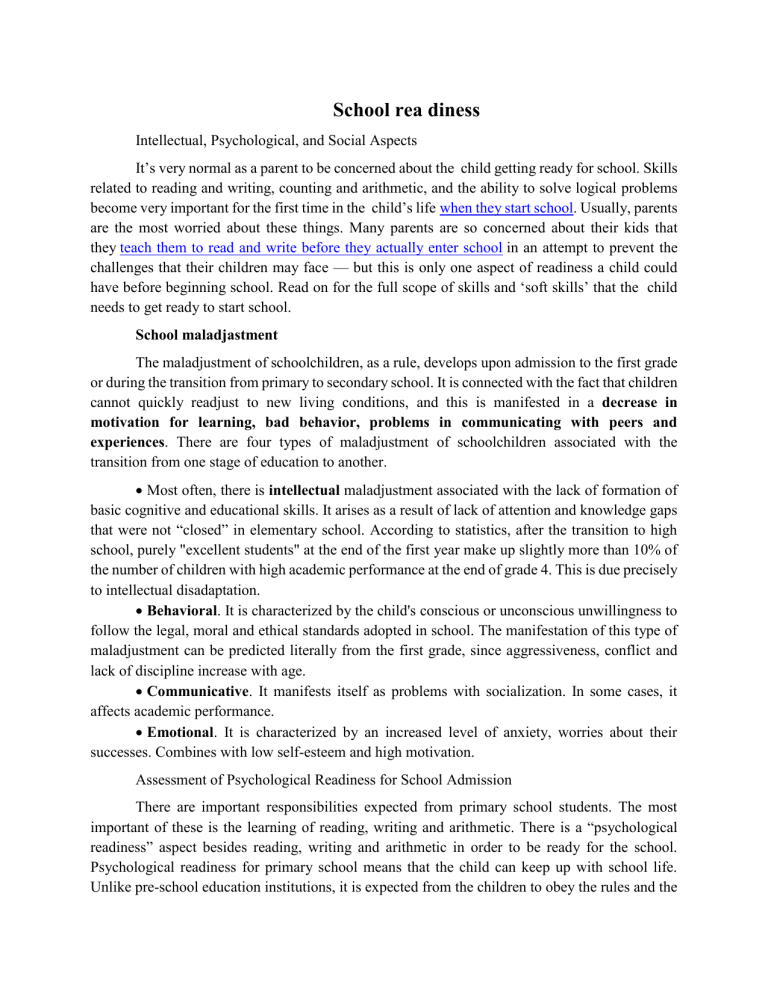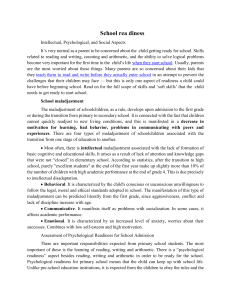
School rea diness Intellectual, Psychological, and Social Aspects It’s very normal as a parent to be concerned about the child getting ready for school. Skills related to reading and writing, counting and arithmetic, and the ability to solve logical problems become very important for the first time in the child’s life when they start school. Usually, parents are the most worried about these things. Many parents are so concerned about their kids that they teach them to read and write before they actually enter school in an attempt to prevent the challenges that their children may face — but this is only one aspect of readiness a child could have before beginning school. Read on for the full scope of skills and ‘soft skills’ that the child needs to get ready to start school. School maladjastment The maladjustment of schoolchildren, as a rule, develops upon admission to the first grade or during the transition from primary to secondary school. It is connected with the fact that children cannot quickly readjust to new living conditions, and this is manifested in a decrease in motivation for learning, bad behavior, problems in communicating with peers and experiences. There are four types of maladjustment of schoolchildren associated with the transition from one stage of education to another. Most often, there is intellectual maladjustment associated with the lack of formation of basic cognitive and educational skills. It arises as a result of lack of attention and knowledge gaps that were not “closed” in elementary school. According to statistics, after the transition to high school, purely "excellent students" at the end of the first year make up slightly more than 10% of the number of children with high academic performance at the end of grade 4. This is due precisely to intellectual disadaptation. Behavioral. It is characterized by the child's conscious or unconscious unwillingness to follow the legal, moral and ethical standards adopted in school. The manifestation of this type of maladjustment can be predicted literally from the first grade, since aggressiveness, conflict and lack of discipline increase with age. Communicative. It manifests itself as problems with socialization. In some cases, it affects academic performance. Emotional. It is characterized by an increased level of anxiety, worries about their successes. Combines with low self-esteem and high motivation. Assessment of Psychological Readiness for School Admission There are important responsibilities expected from primary school students. The most important of these is the learning of reading, writing and arithmetic. There is a “psychological readiness” aspect besides reading, writing and arithmetic in order to be ready for the school. Psychological readiness for primary school means that the child can keep up with school life. Unlike pre-school education institutions, it is expected from the children to obey the rules and the achievements are evaluated in the primary schools (Rybina, 2001; Gutkina, 2005. Many studies have been done on the readiness of the children to the school. In most of these surveys, the criterion for starting school supports the academic skills and physical development of the child. Uyanık and Kandır (2010) emphasized the importance of early academic skills training in preschool period. In this research, they mentioned that early academic skills training promotes children's readiness to primary education and contributes to their success in advanced academic skills. The recommendations are given to the parents and educators working in this field about the features of literacy skills and math skills and the basic skill affecting these skills. Erkan (2011) examined children's readiness to school according to the socioeconomic level of the family. The study found that the readiness level of the children in the upper socioeconomic group was higher than the children in the lower socioeconomic group. He picked on the fact that the reading and writing environment in the preschool period and the acquisition of verbal and mathematical skills are the crucial factors to prepare the child for the school. According to Tuncel (1992), children coming from an environment that offers a rich stimulating environment and experience in literacy, learn to read more easily. Academic readiness to school includes the child's skills such as recognizing colors, letters and numbers, and counting by heart. Physiological readiness to the school includes the close and confidential relations of the child with the peers and teachers, verbal expression of the needs and feelings, participation to the activities (Borozinets, 1998; Volkova, 2001; Venger, 2005). It is necessary for children who are starting the primary school to come to a certain level in terms of their physical, mental, social and emotional development to be able to keep pace with the innovations they face in the school and to be ready to fulfill the expectations in school successfully. A child who has reached the school maturity can easily fulfill the expectations and develop positive feelings and attitudes toward the school. A child who does not reach the school maturity may face some problems when they start the 1st grade. A child who fails to fulfill the expectations in the school may have negative feelings towards the school and self, and the learning motivation may be impaired (Bolotina & Komarova, 1998). First-grade children who are “in race” with their peers need a variety of activities that will carry them to a “good place” on the social scene. Vygotsky has argued that they may experience an internal conflict between the feelings and impulses of the individual “interests” of 6-7 year old children and the attitudes to meet the social expectations. The new responsibilities they are facing, the changing expectations of their close circle, and the child's concerns about fulfilling these expectations reinforce the inner conflict. While trying to meet social expectations on the one hand, the child has to cope with the weakness of the control mechanism on his own impulses. The social expectations (parents, teachers) are an obstacle to meet the child's internal needs (Borodina, 2002; Kravtson, 2005). According to Vygotsky, it is possible to collect pre-school children (6 years old) in two different groups in terms of school maturity. 1) The children who are psychologically ready to adapt the school. The children in this group are ready to start the school, both physically and mentally. These children are able to control the impulses, and mature enough to obey rules and take responsibility. 2) The children who are not psychologically ready to adapt the school. Children in this group are not psychologically ready to start school, although they are mature in physical terms. They are insufficient to obey the rules and take responsibility. They may experience adjustment problems in behaviors that require impulse control, such as doing homework, sitting in school desk, waiting for their turn, and being silent. Instead of taking such responsibilities, they may prefer to play games (Bojovich, 1968). A crisis can occur when children, who are not psychologically ready for the school, take responsibility, as they do not gain the internal power to fulfill the expectations of the school. For example; to ask a child who does not “internally” have the responsibility of doing homework, and to ask a child who does not want to be separated from his/her mother to stay without her mother in the class is demanding something from the child that they “do not have”. It is not possible to create a positive feeling about the school of a child who starts the school in this way. In particular, a child with a teacher and a parent that has a high expectation level may inevitably experience a conflict. Responsibilities that the child has to fulfill on the one hand, and the lack of potential to fulfill those responsibilities on the other, constitutes an internal conflict in the child. While the psychologically ready child is excited for starting the school, it is worrisome for the child who is not psychologically ready child to start school. “Vital” skills such as the ability to tie the shoe laces, to express their needs such as going to the toilet, to ask questions about things they do not understand during the lesson, and to memorize the phone number of their mother or father for a child starting the school is as important as reading and writing. It is inevitable that a child who can meet their needs independently will be more successful in adapting to a new orientation. In this study, among the first-grade students, those who were academically ready were compared with those who were psychologically ready. It is assumed that the child is literate at the basic level, can count up to 100, and knowing all the main colors is “Academically ready for the school”. “Psychologically ready for school” is assumed that the child is able to obey the school rules, go to the school alone, tie the shoelaces, know the home address, and the telephone number of the parents. Within this framework, is the student who knows how to read or write or who can tie shoelaces among the first-grade students? Are the children who can count up to 100 or know their mother and father's phone number by heart? Is the student who knows all the colors or knows the address of the home by heart? To try to find answers to such questions. In pursuit of knowledge and skills, many parents do not think about how to psychologically prepare their kids for this huge adjustment. It is not only the academic challenges that will be new to the first graders or year one students, but there will also be new children, teachers, and a system of rules, regulations, and assessment. When assessing a child’s readiness for school, specialists usually consider such indicators as the child’s: desire to learn new things; ability to concentrate and hold attention in accordance with the instructions and rules; ability to initiate and maintain conversations with teachers and children, to ask clarifying questions, and to defend their point of view; ability to organize and maintain group interaction in class and free time; self-control and self-organization; Getting Ready for School Intellectually When considering getting ready for school, most parents are primarily focused on the intellectual readiness of the child for school. Intellectual readiness includes: sufficient knowledge and understanding of their environment, development of cognitive functions, such as attention, memory, critical thinking, perception, imagination, speech, etc. understanding of knowledge required for school learning (awareness of the concepts of mathematics, reading, and writing) Without a doubt, the above described knowledge is very valuable, however, perfect adaptation of the child to school is never guaranteed. There will be challenges no matter what, but the child’s interest in learning and gaining knowledge along with sufficient communication skills will surely be crucial. It is absolutely vital to remember that parents only need to pay attention to preparing their children to learn to read and write, and not their actual reading and writing skills. Teachers will teach them how to read and write at school! Personally and Emotionally Getting Ready for School Aside from intellectually getting ready for school, there are also important aspects to consider such as interpersonal relationships and maturity. Personal preparedness for school involves a set of considerations such as: motivation to learn: Does the child wants to go to school? Do they understand the importance of the learning process? Are they interested in acquiring new knowledge? ability to behave according to the rules: Does the child have the capability to act in accordance with the school rules, even if the child does not want to? Does the child understand when rules need to be followed and that they should respect and listen to their teachers? self-control, proper behavior, ability to identify own mistakes and correct them. Can the child sit still for multiple hours and behave? If the child makes a mistake, do they have the emotional maturity and insight to realize it and apologize? Most importantly, can they learn from their mistake and not repeat it? According to many scientists and practitioners, it is personal maturity that is the critical factor of a child’s readiness for school. The child’s desire to learn new things and their ability to manage activities and behavior will generally be proportional to the intellectual readiness of the child, and subsequently contribute to the sociometric status in the group. Personal maturity of a child includes the ability to fulfill the requirements of the teacher, and to control their own behavior. Social and Communicative Readiness for School Childrens’ adaptation to school depends largely on their ability to communicate with other children and teachers. Communication readiness includes the following: child’s willingness to communicate with other children, to participate in group activities, to accept opposite opinions and to obey the rules of children’s groups; the ability to initiate and maintain the activities of others, to negotiate and compromise, and to express a personal point of view; sufficient emotional stability and self-regulation — ability to adequately assess the situation and constructively express own emotions in communication with others while reducing the number of impulsive reactions. Obviously no first-grader will be completely emotionally mature, but in general it is important that the child is not at a significantly different level than their peers. Remember that there will definitely be social challenges no matter what, so try to patient and help the child be patient at first. Psychological and Physical Readiness for School In addition to all the above, the psychological readiness of the child to school will be influenced by the physiological factors: development of fine motor skills: how confident is the child with scissors and pencil? spatial orientation, coordination of movements: Can the child correctly determine the relative positions of objects and movement directions: higher-lower, more-less, forwardbackward? motor dexterity, including different motor skills such as running, jumping, tying shoelaces, etc. lateralization (which hand is leading) that affects the orientation in space and on the paper. Does the child know left and right? visual-motor coordination in the eye-hand system: can the child can draw simple shapes that are recognizable? Considering the above, school readiness is a combination of skills and abilities that characterize the maturity of the child and their ability to socialize appropriately and do various learning exercises. However, a child will face emotional and psychological challenges in the case of the absence of some of the previously discussed crucial skills. Within psychosocial adaptation authors specify school adaptation, which is perceived as a process of an individual’s (pupil’s) active adjustment to the new changed conditions of a social environment, i. e. school. According to Bogomolov (In Saburčev et al., 2013) school adaptation involves a pupil’s adjustment to new educational conditions and social situations, a new daily routine as well as new interpersonal relationships, given requirements and demands. When a child enters a new environment, he/she has to adapt to new requirements and has to adopt new social roles. Therefore specialists agree that the basic condition of adaptation is man’s identification with a social role. Gennadevna (2012) also defines school adaptation as a process in which a pupil adjusts to the new social conditions of the institution, which is connected with the acceptance of new social roles and the development of new social relationships. According to the author, the level of adaptation is therefore the indicator of the stabilisation of the social development of the child’s personality. Soloveva (2012) and Rumjanceva (2012) are of a similar opinion and specify three aspects, or rather forms, of school adaptation: adaptation of an organism to new environmental conditions, new activities and to physical and intellectual strain, adaptation in respect of new social relationships and contacts, adaptation to the new conditions of learning activity Children aged six to seven are not yet able to regulate the process of their adaptation. Therefore school and a family environment play a significant role. Teachers and parents act as the primary participants and determinants of the process. For this reason the adaptation process has its specific dimensions, i. e. the child’s adjustment to school, the adjustment of school to the child and the family dimension of adaptation. Regarding the child’s adaptation to school requirements, it is necessary to consider the fact that it is a preschool child that starts school and his/her position of a schoolchild is gradually formed. The child becomes a member of a new social group and gains a certain social status. He/she gradually adopts the role of a schoolchild. For him/her this role is an obligatory, formal and inferior one (Vágnerová, 2001). The adoption of the role of a schoolchild, during which the pupil seeks his/her personal and social identity in a group, has an individual character, since each individual deals with it in a different way. It involves identification with the role of a pupil and fellow pupil. Significant factors in the process of adaptation include the preparedness of schools, teachers’ professional preparedness and, naturally, the teacher’s personality as well. It is necessary to consider the fact that while play at nursery was a means of the development of the child’s personality and the basis of learning activity, in the first grade it usually completely disappears. Therefore it would be good, at least in the first months after starting the first grade, to gradually transfer from play activities to learning activities so that the child experiences a less “shocking” transition. The need to apply play is accentuated also by Vekerdy (2010) who claims that although the child’s school adaptation starts to form at about five years of age, this “corticolisation process”, which is connected with organism maturing, does not finish until the child is seven or eight years old. Based on this it is recommended that the continuity of pre-primary and primary education should be ensured so that the character of classes in the first and second grades is similar to the process of instruction at nursery. According to Slezáková (2012) it is also advisable to eliminate risk factors on the part of schools such as: the teacher’s stressful pedagogical tactic, excessive intensification of the teaching process, inadequate methods and forms, the teacher’s knowledge being insufficient, the teacher’s personality being unsuitable, the teacher’s approach being tactless, lack of the system of work, non-acceptance of age and individual peculiarities, inadequate expectations, humiliating children, etc. Research results showed that in the classes where the teacher was very strict and directive the number of long-term ill children increased three times compared to the classes taught by an agreeable and nice teacher (Bezrukich, Jefimovova, 2001). Naturally, this dimension of adaptation is also influenced by the material technical and spatial conditions such as classroom arrangement, equipment, etc. Equally important determinants also include the planning of educational work and the organisation of educational activities. When starting the first grade, the pupil’s success is largely determined by the pupil’s family environment, his/her parents’ expectations and approach. Particularly close attention needs to be paid to this dimension since the extent to which the child succeeds in his/her role of a pupil largely depends on the preparedness of parents to manage their role – the one of the pupil’s parents. The child’s successful transition to school depends, for the most part, on the quality of the conditions which parents create for their children in their family. Therefore parents’ preparedness becomes a significant factor in adaptation. Chomenko (2007) specifies the following criteria of parents’ preparedness: psychological, pedagogical, social and legal and material preparedness. Lawson and Lawson (1997) highlights the need for parents’ active engagement in the improvement of children’s living space. Rabušicová and Pol (1996) find it important to apply Hornby’s model of parental involvement. However, they point out that parents’ needs and possibilities are differentiated. We agree with Wong (2001), who points out the need for cooperation between schools and parents, which should be initiated by schools in order to ensure a more flexible transition. According to him, nowadays schools are already expected to prepare a set of strategies with regard to the following aspects: health, social contacts, learning skills (habits and routine). Adaptation to school for a six-year-old child should be understood as: a) physiological adaptation, as the process of adapting the functions of the child's body to the learning environment at school; b) socio-psychological, as a process of active adaptation of the system "child-adult", "childchild" to the new conditions of interaction. Socio-psychological adaptation includes the development of the child's cognitive sphere and his ability to subordinate perception, memory, thinking, imagination to the tasks that are set before him in the learning process. Adaptation to new social relations and connections, in which the personality of the child begins to manifest itself, is determined by how the child enters a new group of peers, what place he begins to occupy in the class, how he communicates with peers and adults, how he relates to school, to himself as schoolboy. Of great importance in adapting a child to school is the level of education of the parents, the absence of conflict situations in the family, the correct methods of upbringing, full-fledged communication with the child, interest in preparing the child for school. Reasons for school maladjustment They can be subjective and objective. Subjective reasons for maladjustment: Insufficient level of motivation to study at school. A negative attitude towards school, the primary reasons for which may be insufficiently professional work of preschool institutions, an example of a negative attitude towards the school of brothers and sisters, etc. etc. The secondary destruction of motivation occurs directly in the learning process. Lack of formation of elements and skills of educational activity, the cause of which can be both individual characteristics of the development of intelligence, and pedagogical neglect. Inability to voluntarily regulate behavior, attention, learning activities. The reason may be an unfavorable family environment, improper parenting methods, improper organization of the child's day regimen, as well as the consequences of complications during pregnancy and childbirth in the mother. Inability to adjust to the pace of school life. More often it happens in children who are somatically weakened, with a delay in physical development, and disturbances in the work of analyzers. Objective reasons for school maladjustment: Wrong attitude of the teacher to the student. Incorrect organization of the educational process. Depending on the severity of symptoms and their combination, the following forms of adaptation are distinguished - maladjustment The norm is a favorable course of adaptation, accompanied by a weak expression or absence of negative symptoms of maladjustment. "Hidden" forms of SM: 1st degree - the initial form of "hidden" SM. It is characterized by an average level of performance, decreased emotional tone, partial disinhibition, tearfulness. Increased fatigue. Desire to go to school is unstable. Diligent, but slowly joins in the educational process, activity is replaced by passivity, responds adequately to remarks. Anxiety and uncertainty are observed in behavior. 2nd degree - progressive form of "latent" SM. It is characterized by low efficiency, high fatigue, the child cannot concentrate, crying, touchy, irritable. Sometimes he complains of headache, nausea, abdominal pain. The attitude towards school is negative, passive in the lesson, he is silent when asked to answer, he is indifferent to failures. Needs constant supervision and help from a teacher. Aggressiveness towards children is occasionally observed as a protective reaction of the body. "Open" forms of maladjustment 3rd degree - the initial form of "open" SM. It is characterized by a medium-low level of performance, impulsivity, disinhibition, unstable attention, decreased appetite, restless sleep. In the lesson is not collected, quickly loses interest in assignments, in educational activities sometimes creates a conflict situation. 4th degree - progressive form of "open" DA. It is characterized by low efficiency, high fatigue, impulsivity, disinhibition, irritability turns into aggressiveness. Negative attitude towards school, teacher, quickly loses interest in assignments, refuses to complete them, is indifferent to failures, has a negative attitude to comments, interferes in the lesson, needs constant monitoring. There is a decline in the success of training, demonstrativeness is manifested in communication with the teacher. Grimaces, refuses to fulfill the teacher's requirements, creates a conflict situation. In dealing with children, he is aggressive, calls children names, complains to the teacher. Types of school maladjustment Before describing the types of school maladjustment, you need to highlight its criteria: - academic failure in programs that correspond to the age and abilities of the student, along with such signs as repetition, chronic academic failure, lack of general educational knowledge and lack of necessary skills; - disorder of emotional personal attitude to the learning process, to teachers and to life opportunities associated with learning; - episodic non-corrective behavior disorders (anti-disciplinary behavior with demonstrative opposition to other students, disregard of the rules and obligations of life at school, manifestations of vandalism); - pathogenic maladjustment, which is a consequence of disruption of the nervous system, sensory analyzers, brain diseases and manifestations of various fears; - psychosocial maladjustment, which acts as the gender and age individual characteristics of the child, which determine his non-standard and require a special approach in school conditions; - social maladjustment (undermining order, moral and legal norms, asocial behavior, deformation of internal regulation, as well as social attitudes). There are five main types of manifestations of school maladjustment. The first type is cognitive school maladjustment, which expresses the failure of the child in the process of teaching programs that correspond to the student's abilities. The second type of school maladjustment is emotional and evaluative, which is associated with constant violations of the emotional and personal attitude both to the learning process in general and to individual subjects. Includes anxiety and worries about problems arising in the school. The third type of school maladjustment is behavioral, it consists in the repetition of violation of forms of behavior in the school environment and learning (aggressiveness, unwillingness to make contact and passive-refusal reactions). The fourth type of school maladjustment is somatic; it is associated with deviations in the physical development and health of the student. The fifth type of school maladjustment is communicative, it expresses difficulties in determining contacts, both with adults and with peers.








